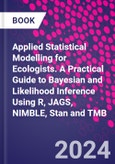**2025 PROSE Award Finalist in Environmental Science**
Applied Statistical Modelling for Ecologists provides a gentle introduction to the essential models of applied statistics: linear models, generalized linear models, mixed and hierarchical models. All models are fit with both a likelihood and a Bayesian approach, using several powerful software packages widely used in research publications: JAGS, NIMBLE, Stan, and TMB. In addition, the foundational method of maximum likelihood is explained in a manner that ecologists can really understand.
This book is the successor of the widely used Introduction to WinBUGS for Ecologists (K�ry, Academic Press, 2010). Like its parent, it is extremely effective for both classroom use and self-study, allowing students and researchers alike to quickly learn, understand, and carry out a very wide range of statistical modelling tasks.
The examples in Applied Statistical Modelling for Ecologists come from ecology and the environmental sciences, but the underlying statistical models are very widely used by scientists across many disciplines. This book will be useful for anybody who needs to learn and quickly become proficient in statistical modelling, with either a likelihood or a Bayesian focus, and in the model-fitting engines covered, including the three latest packages NIMBLE, Stan, and TMB.
Please Note: This is an On Demand product, delivery may take up to 11 working days after payment has been received.
Table of Contents
1. Introduction
2. Introduction to statistical inference
3. Linear regression models and their extensions to generalized linear, hierarchical and integrated models
4. Introduction to general-purpose model-fitting engines and the model of the mean
5. Simple linear regression with Normal errors
6. Comparison of two groups
7. Comparisons among multiple groups
8. Comparisons in two classifications or with two categorical covariates
9. General linear model with continuous and categorical explanatory variables
10. Linear mixed-effects model
11. Introduction to the Generalized linear model (GLM): Comparing two groups in a Poisson regression
12. Overdispersion, zero-inflation and offsets in a GLM
13. Poisson regression with both continuous and categorical explanatory variables
14. Poisson mixed-effects model or Poisson GLMM
15. Comparing two groups in a Binomial regression
16. Binomial GLM with both continuous and categorical explanatory variables
17. Binomial mixed-effects model or Binomial GLMM
18. Model building, model checking and model selection
19. General hierarchical models: Site-occupancy species distribution model (SDM)
20. Integrated models
21. Conclusion








